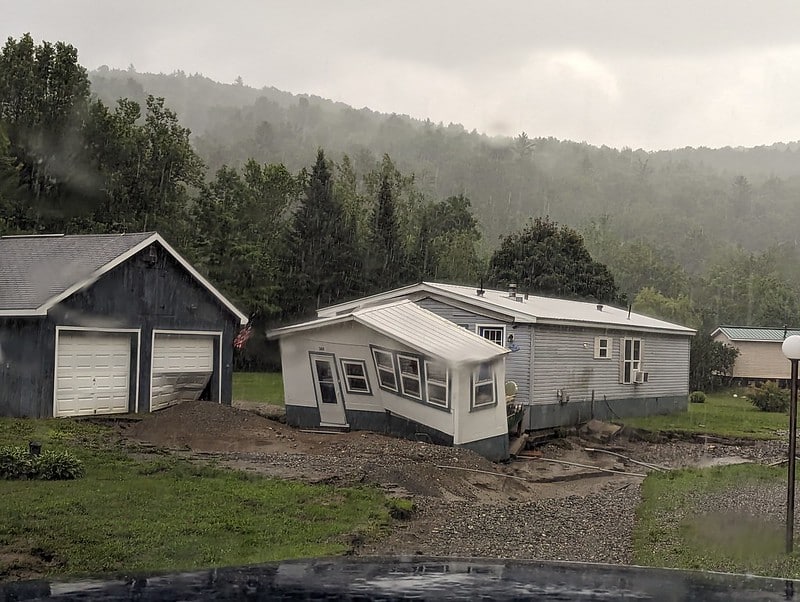
On July 15th, a Saturday, Vermont Governor Phil Scott had plans for an ambitious but celebratory bike ride through some of the prettiest sections of his home state. The occasion was the official opening of the 93-mile Lamoille Valley Rail Trail (LVRT). New England’s longest cycling path, the LVRT extends across five counties and connects 17 towns, from St. Johnsbury to Swanton.
More than just a pleasant ride, however, the Lamoille had long been seen as a possible economic boon to the communities that resided on or near its route. It’s why the state had spent more than $30 million on its development.
Among the many stops Scott planned for that day was an early afternoon water break in Johnson, a community of 3,500 residents located in the Northeast Kingdom, just an hour north of Stoweand an hour east of Burlington. Johnson’s attractions, though, extend far beyond its proximity to Vermont’s more celebrated destinations. Northern Vermont University makes its home there, as does the acclaimed Vermont Studio Center, whose offerings include the largest fine arts and writing residence program in the country. A section of the famed Long Trail also scampers between the town’s borders.
The Lamoille only promised to add to the area’s appeal and like other communities along its route, Johnson leaders and business owners saw the hiking and cycling route as a path forward for a bigger tourist economy. So did the Governor Scott, who planned to celebrate the new trail’spossibilities.
He never got the chance.
The Vermont floods didn’t just postpone the Lamoille’s opening ceremonies, it devastated the trail as it sent small towns like Johnson into upheaval. Sections of the path, including a bridge in Hardwick were completely wiped out; weeks after the rains first fell, more than half of the LVRT remains closed to the public.
That includes the nine miles that run through Johnson. While communities like Ludlow and Montpelier made national headlines, Johnson’s devastation was no less severe. No facet of community life went untouched. Emergency services oversaw 28 flooding rescues and an American Cross-managed shelter was established at the college for the many residents forced out of their homes.

Elsewhere, the town’s wastewater plant was taken offline, the town’s lone grocery store was wiped out, the central municipal building flooded, as did the library. On Lower Main Street, the community’s only doctor’s office, the Johnson Health Center, which had only opened eight months before, was shut down.
“Just a lot of trauma,” says Beth Foy, who chairs the select board and since April has served as the town’s emergency information officer. “Whether that’s the people who had to be rescued or the people who did the rescuing.”
Still, if there was a moment when residents thought that Johnson might not recover, that was dispelled even before the rains stopped falling. As soon as it was safe to do so, Fay says, residents got to work, banding together in a way the Johnson native found heartening.
“It’s always nice to meet people in your community that you’ve never met before,” says Foy.“And I think that everyone in Johnson has met someone in Johnson that they hadn’t met before, and that’s really great.”
Foy says that for weeks after the flood, residents who’d been spared the worst of the storm, turned out to help those most in need; mucking out muddied basements, gutting homes. Others delivered food and water, or volunteered at the shelter. “A local Mennonite family brought in members of the Mennonite community in Pennsylvania to help out,” says Foy. “They worked so hard to help with the cleanup. All around town there was this network that was established that was more expansive than we’ve seen before.”
The work, of course, continues. Some 200 households were displaced and it will probably be months before Sterling Market is able to reopen. However, downtown life is percolating. Places like Jenna’s Coffee House and the Mexican restaurant, Marcella Salsa, both of whichexperienced serious basement flooding, are welcoming customers. By early August, all of the town’s roads were back online, and houseless residents had been able to move out of the shelter and into secure temporary housing. Even the community’s big summer event, Tuesday Night Live, a weekly concert series with food trucks and vendors, is entertaining again.
“I’m really grateful at how our community has pulled together and protected one another,” says Foy. “It was a very humbling experience to go through. It’s not over and it can be daunting to think about what lies ahead. But I’m also proud of what our community has done and will continue to do.”
Vermont Flooding Resources:
• The Okemo Valley Regional Chamber of Commerce, in partnership with FEMA and the Small Business Administration is operating a small business recovery center. For more information can be found here.
• The Okemo Valley Regional Chamber of Commerce also operates a blog with a running list of area businesses that have reopened their doors.
• To apply for federal assistance, visit disasterassistance.gov or call 1-800-621-3362.
• To find more additional help, visit Vermont.gov/flood, vermont211.org or call Vermont 2-1-1.


